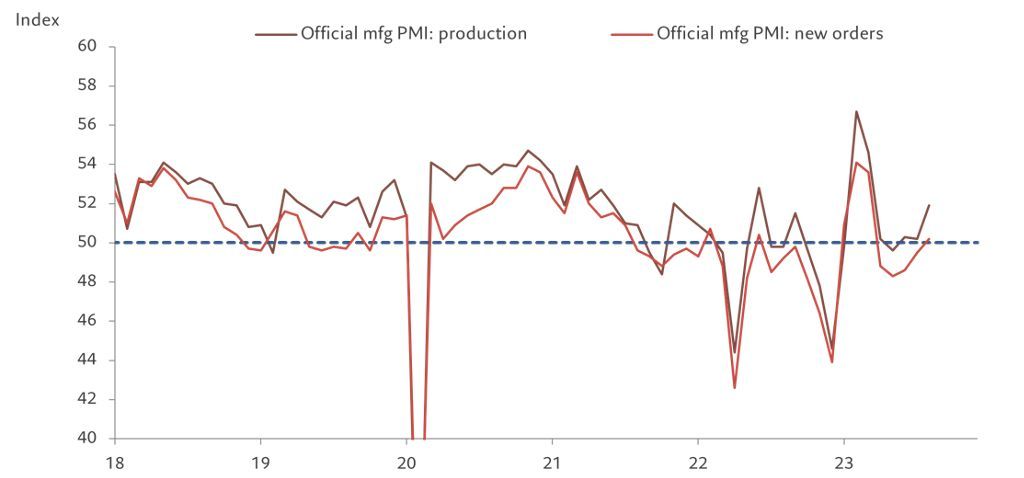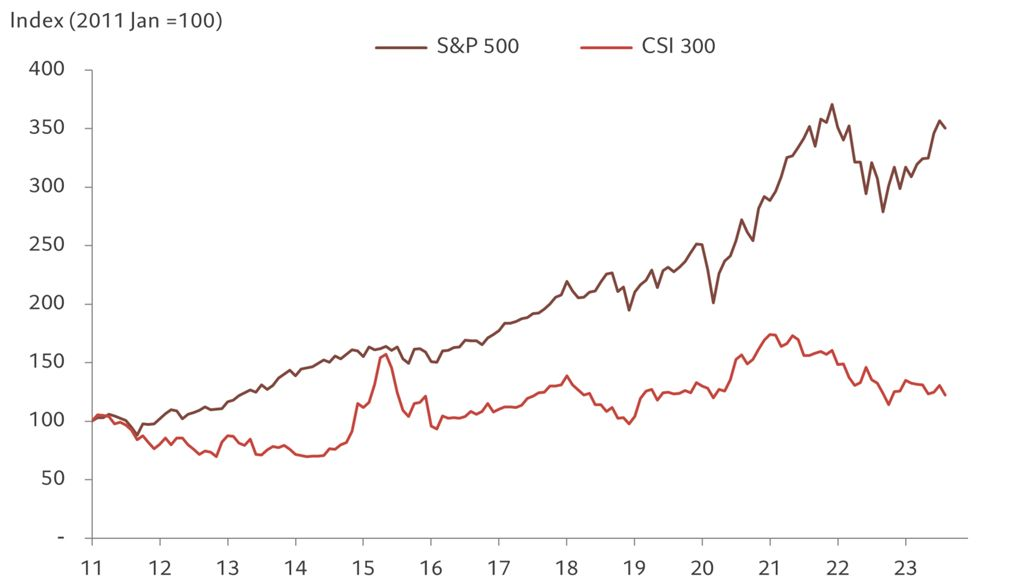Pictet Wealth Management
Strengthening policy support and signs that manufacturing is stabilising point to a moderate recovery over the rest of the year, although China’s longer-term growth potential is weakening.
In recent weeks, missed debt repayments by another major property developer and one of the largest shadow-banking institutions have triggered fears of systemic financial risks in China. In our view, however, such concerns are overblown due to the Chinese banking sector’s limited direct exposure to property developers and the relatively small (and shrinking) size of shadow banking activities. In addition, the authorities have taken action to alleviate the acute liquidity stress in parts of the private sector and at some local governments.
Since late August, policy support in China has picked up in pace and strength. While the measures announced are no ‘bazooka’, they are concrete enough and are being implemented quickly so that they could lead to some real improvement in the near term.
Policy measures exceed expectations
Many of the policy measures are focused on the property sector. On 31 August, a cut was announced in the nationwide minimum down payment ratio for first-time buyers to 20% (from 30% previously) and for second-time buyers to 30% (from 40% previously and in some cities as high as 70% in practice). In addition, commercial banks were told to lower the interest rate on existing mortgages taken out by first-home buyers. The scope of these policy measures exceeds market expectations and will likely boost housing demand and market sentiment in the near term. And the reduced financial burden on many homeowners may help bolster the recovery in household spending, which has been sluggish because of low confidence.
We think that concerns about systemic risk in the Chinese financial sector are overblown
Fiscal measures have picked up speed too, with instructions issued to local governments to complete planned 2023 issuance of special bonds that fund infrastructure investment by end-September, and to fully deploy the proceeds by end-October. Important measures have also been taken to address the ballooning local government debt problem, especially debt borne by the so-called local government financing vehicles (LGFVs). On the monetary front, we expect the People’s Bank of China to stay in easing mode. After earlier-than-expected rate cuts in August, the central bank may reduce banks’ reserve requirement ratio again before the end of this year.
Boosting investor sentiment
In addition to measures to help the real economy, the government has made efforts to boost sentiment in the equity market. These include a halving in the stamp duty and a reduction in the required margin ratio on equity trading. Measures were also announced to slowdown the pace of initial public offerings and to tighten new share issuance by existing companies. New restrictions have also been introduced to control stock sales by major shareholders of companies that do not reach certain minimum requirements in areas such as dividend pay-outs and price-to-book ratios.
Furthermore, the most recent data has mostly beaten expectations in areas such as retail sales, industrial production and business sentiment. Purchasing manager indexes for manufacturing are improving and inflation ticked up again in August.
To summarise, since the Politburo meeting in late July, policy support has started to intensify in both pace and strength. The magnitude of some policy measures has exceeded our expectations. While these measures may not be strong enough to engender a sharp economic rebound, the ones that target the property sector may serve to draw a line under very depressed sentiment in the housing market. Indeed, right after the announcement of the cuts in down payment ratios and the expansion of the first-time buyer definition, housing transactions surged in Beijing and Shanghai.
China’s longer-term potential is fading
These developments, combined with some nascent signs of stabilisation in manufacturing activity, have strengthened our conviction that the Chines economy may recover moderately in the second half of 2023. We have decided to keep our current GDP forecast for this year unchanged at 5.2% for now, slightly above the government’s growth target of around 5%.
Chinese official mfg PMI: production and new order sub-indices

Source: Pictet Wealth Management, Bloomberg Finance LP, as of 06.09.2023.
We expect the Chinese economy to grow by an average annual rate of about 4% in the coming years, but growth could decline to 3.7% in 10 years’ time.
While we do not expect a financial meltdown and while we expect the economy to stabilise, the property slump will likely cost the Chinese economy in terms of long-term growth potential, primarily because of a sharp slowdown in investment. The expected deceleration in fixed-asset investment, combined with other headwinds such as deteriorating demographics and de-globalisation, have led us to revise down our long-term growth expectations for China earlier this year. After the post-covid rebound, we now expect China’s real GDP to grow at an average annual rate of about 4% over the next few years (80-90 bps lower than our previous forecast in 2022) and we believe China’s annual growth potential may decline to 3.7% in 10 years’ time.
Chinese equities have some near-term upside
Despite low valuations (with 12-month forward price-earnings ratios of around 10x and 11.7x for offshore and onshore stocks, respectively), which look even more stretched on a sector-adjusted basis, investors are clearly not queuing to pile into Chinese stocks. The earnings picture, too, remains unappealing, as growth expectations remain too high and revisions have turned steadily negative, particularly in USD terms.
Although the overall picture looks grim, the prevailing bearishness around Chinese equities makes them ripe for a rebound at some point. While valuations are rarely a reliable indicator in the short term, positioning can be. Managers of emerging-market funds currently hold an average 4% underweight on Chinese equities versus their benchmark, which is high by historical standards. Outflows from Chinese equities have been very high recently.
All things considered, we have decided to maintain our exposure to Chinese equities and our overall neutral stance on EM Asian equities. While scepticism around the lasting impact of government stimulus is understandable, the recently announced policy measures combined with weak positioning and low valuations hold out the possibility of some upside potential. We have revised down our target for the MSCI China to HKD65 (from HKD76 set at the beginning of the year), driven by a slight downgrade in valuations and high single-digit earnings growth.
S&P500 vs. CSI300 price indices
Source: Pictet Wealth Management, Bloomberg Finance LP, as of 06.09.2023.





